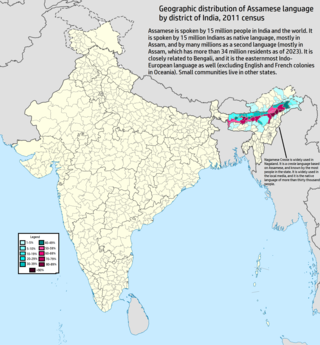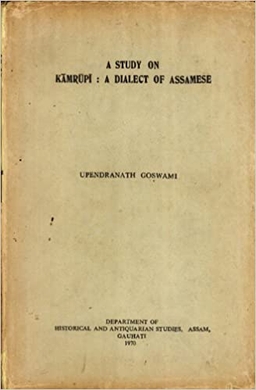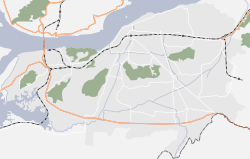
Assamese, also Asamiya, is an Indo-Aryan language spoken mainly in the north-eastern Indian state of Assam, where it is an official language, and it serves as a lingua franca of the wider region. The easternmost Indo-Iranian language, it has over 15 million speakers according to Ethnologue.

Kamarupi Prakrit is the postulated Middle Indo-Aryan (MIA) Prakrit language used in ancient Kamarupa. This language is the historical ancestor of the Kamatapuri lects and the modern Assamese language; and can be dated prior to 1250 CE, when the proto-Kamta language, the parent of the Kamatapuri lects, began to develop. Though not substantially proven, the existence of the language that predated the Kamatapuri lects and modern Assamese is widely believed to be descended from it.
Nalbari is a town and a municipal board in Nalbari district in the Indian state of Assam. Nalbari town is also the headquarters of Nalbari District. The town is one of many towns covered under the proposed State capital region.

Goalpariya is a group of Indo-Aryan dialects spoken in the Goalpara region of Assam, India. Along with Kamrupi, they form the western group of Assamese dialects. The North Bengali dialect is situated to its west, amidst a number of Tibeto-Burman speech communities. The basic characteristic of the Goalpariya is that it is a composite one into which words of different concerns and regions have been amalgamated. Deshi people speak this language and there are around 20 lakhs people.

Assamese literature is the entire corpus of poetry, novels, short stories, plays, documents and other writings in the Assamese language. It also includes the literary works in the older forms of the language during its evolution to the contemporary form and its cultural heritage and tradition. The literary heritage of the Assamese language can be traced back to the c. 9-10th century in the Charyapada, where the earliest elements of the language can be discerned.

Deori is a Tibeto-Burman language in the Sino-Tibetan language family spoken by the Deori people of Assam and Arunachal Pradesh. Among the four territorial groups only the Dibongiya have retained the language. The others—Patorgoyan, Tengaponiya, and Borgoyan—have shifted to Assamese. It is spoken in Lohit district of Arunachal Pradesh, and in Lakhimpur, Dhemaji, Tinsukia, and Jorhat districts of Assam.

Kamrupi dialects are a group of regional dialects of Assamese, spoken in the Kamrup region. It formerly enjoyed prestige status. It is one of two western dialect groups of the Assamese language, the other being Goalpariya. Kamrupi is heterogeneous with three subdialects— Barpetia dialect, Nalbariya dialect and Palasbaria dialect.
Bhattadeva (1558–1638)(অসমীয়া: বৈকুণ্ঠনাথ ভাগৱত ভট্টাচাৰ্য), is acknowledged as the father of Assamese prose. Though Bhaktiratnakar-katha, the Assamese translation of Sankardev's Sanskrit composition Bhaktiratnakar by Gopala Charana Dwija preceded the works of Bhattadeva, Bhattadeva's prose had an influence in the development of a high and dignified style. Bhattadeva's and Gopala Charana Dvija's 16th century works are considered to be the earliest examples of prose in Indian languages. Bhattadeva's erudition in Sanskrit grammar and literature, and his command over the Bhagavata earned him the title of Bhagavata Bhattacharya.
Ananta Kandali was Brahmin poet from Hajo, Kamrup district. Ananta Kandali's real name was Haricharan, but he is popularly known by his scholastic title "Ananta Kandali". His father, Ratna Pathak, was a renowned scholar and expounder of the Bhagavata at the Madhava temple.

Kamrup is the modern region situated between two rivers, the Manas and the Barnadi in Western Assam, with the same territorial extent as the Colonial and post-Colonial "Undivided Kamrup district". It was the capital region of two of the three dynasties of Kamarupa and Guwahati, the current political center of Assam, is situated here. It is characterized by its cultural artifacts.

A Study on Kamrupi: A Dialect of Assamese is a book on Kamrupi dialect of the Assamese language, written by Upendranath Goswami. It gives detail account of origin and development of Kamrupi language, spanning a period of early first millennium CE to modern times. It discusses the growth of Kamrupi literature, from its apabhramsa stage in form of copper plates, seals, Charyapada to literature developed in mid twentieth century.
Kamrupi culture refers to the cultural norms of people of colonial Kamrup district.

Kamarupi script was the script used in ancient Kamarupa from as early as 5th century to 13th century, from which the modern Assamese script eventually evolved. In the development of the Assamese script, this phase was followed by the medieval and then by the modern Assamese scripts.
Sridhara Kandali was medieval vaishnavite poet from Kamrup region of Assam. He was known for his poetry work named "Kumara Harana".
Sarvabhauma Bhattacharya was medieval Pandit and Bhakti reformer from Kamrup. As a vedantist of the Advaita school, he refuted the monistic doctrines of Sankaradeva.
Kalapachandra Dvija was medieval litterateur from Kamrup "Ramayana Chandrika" was one of his notable work.
The Kamrupi people are a linguistic group that speak the Kamrupi dialects of Assamese and are found in the colonial Kamrup district region of Assam, India.
Rama Saraswati was 16th century poet from Kamrup, India. He was well known for translation of entire Mahabharata to Early Assamese from Sanskrit for which he is also known as Axom Byas.
Barpetia dialect is a modern regional subdialect of Kamrupi, a dialect of the Assamese language. Named after the current Barpeta district of Assam, it is the westernmost of the Kamrupi group of dialects. This dialect has community variations within itself.









